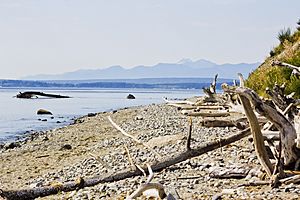Double Bluff Beach facts for kids
Quick facts for kids Double Bluff Beach |
|
|---|---|
 |
|
| Lua error in Module:Location_map at line 420: attempt to index field 'wikibase' (a nil value). | |
| Location | Island County, United States |
| Geology | Beach |
Double Bluff Beach is a beautiful beach and a tall cliff area on Whidbey Island in Washington, USA. It's a popular spot for both locals and visitors. The beach itself is part of Double Bluff State Park. The land above the beach and the parking areas are managed by Island County, Washington as Double Bluff County Park.
Contents
Exploring Double Bluff Beach

Double Bluff Beach is about two miles long. It's located on the southern part of Whidbey Island. The beach sits along the shores of Admiralty Inlet, which is just north of Puget Sound. You can find the beach's parking lot about two miles from the town of Freeland.
From the northern parts of the beach, you can see the amazing Olympic Mountains to the west. If you look south from the beach, you might spot the tall buildings of Seattle, which are about 30 miles away. Even further in the distance, you can see the huge Mt. Rainier, about 100 miles away!
The southern end of the shore faces towards Useless Bay. This bay has a sandy, shallow slope. When the tide goes out, the beach can become very wide. The distance between the high and low tide lines can be more than 2,500 feet! Useless Bay opens to the west into Admiralty Inlet. Here, the shore meets a large cliff that stretches for several miles.
How the Bluffs Were Formed
The beach here is mostly made of shifting sands. These sands come from the tall cliffs, called bluffs, that surround the beach. You'll also find large areas of pebbles, cool pieces of driftwood, flat slabs of peat (which is like very old, compressed plant material), and huge glacial erratic boulders. These boulders were left behind by glaciers long ago.
The bluffs at Double Bluff Beach can be as high as 300 feet. That's like a 30-story building! Wind, rain, and tides have been slowly wearing away these bluffs since the last ice age. This process, called erosion, has revealed many different layers of rock and soil in the bluff faces.
The oldest layers of earth here are from an ice age that happened between 150,000 and 200,000 years ago. The newest layers are at the very top of the bluffs. These layers were formed about 70,000 years ago. Between these two layers is something called the Whidbey Formation. This layer formed during a warmer period between ice ages. It's made of sediments like silt, clay, sand, and pebbles. It also has compressed slabs of peat. What's really cool is that Mammoth teeth and tusks have been found slowly coming out of the bluff as it erodes!
Amazing Wildlife to Spot
Double Bluff Beach is home to many different kinds of animals. Keep your eyes peeled for some incredible creatures! You might see majestic bald eagles soaring overhead. Look for tall, graceful great blue herons near the water. Fast-flying peregrine falcons and fish-eating osprey also live here. Of course, you'll see many types of gulls and clever crows.
Closer to the water, you might spot playful river otters. If you explore the tidepools, you can find many fascinating sea creatures. These include different kinds of sea anemones, various species of crabs, snails, spiky sea urchins, and tiny barnacles stuck to rocks.
Fun Things to Do
Double Bluff Beach is a favorite spot for many people. It's easy to get to, has lots of space, and offers many fun activities. Many visitors enjoy building cool huts and shelters using the driftwood found on the beach. Here are some other popular activities:
- Walking along the long shoreline
- Exploring the tidepools when the tide is out
- Birdwatching to spot all the different birds
- Swimming in the calm waters
- Skimboarding on the shallow water near the shore
- Having a picnic with friends and family
- Clamming (if you have the right license)
- Letting your dog run and play in the off-leash area


